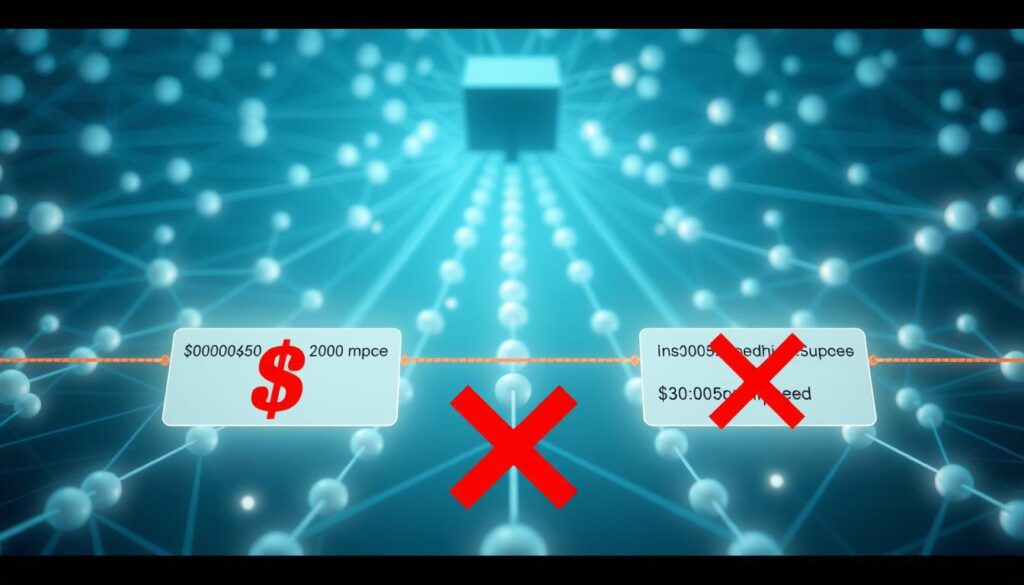Now Reading: Blockchain for Beginners: Understanding the Basics
- 01
Blockchain for Beginners: Understanding the Basics
Blockchain for Beginners: Understanding the Basics
Imagine a digital ledger that can’t be altered, controlled by no single entity, and accessible to everyone. This technology emerged in 2008 when an anonymous figure named Satoshi Nakamoto proposed a peer-to-peer electronic cash system. Their goal? To address distrust in centralized banks after the global financial crisis.

Unlike traditional systems, this innovation relies on a network of computers working together to validate transactions. Every action is recorded permanently, creating transparency and security through advanced cryptography. This approach removes the need for middlemen like banks, putting control back into users’ hands.
Today, this framework powers everything from cryptocurrencies to supply chain tracking. Its immutable nature ensures trust without relying on institutions—a shift reshaping industries globally. Whether you’re exploring earning rewards or verifying data, understanding these principles is essential.
Key Takeaways
- Originated as a response to the 2008 financial crisis and centralized banking flaws
- Decentralized design eliminates reliance on third-party institutions
- Transactions are secured through cryptography and permanent records
- Enables trust through transparency rather than centralized authority
- Forms the backbone of modern digital currencies and applications
Getting Started with Blockchain for Beginners
Think of a shared spreadsheet that updates instantly across thousands of devices, where every change is permanent. This system began as a solution to centralized financial failures, introduced through a groundbreaking 2008 paper by an anonymous creator. Unlike traditional record-keeping, it allows groups to collaborate without intermediaries.

Introducing the Concept and Origin
The core idea resembles a team-managed notebook. When someone adds a transaction—like repaying a $20 loan—all participants instantly receive a verified copy. Pages (blocks) link chronologically, forming an unbreakable chain. This design emerged to enable peer-to-peer exchanges without banks or governments overseeing them.
Why Learning This Matters
From tracking medicine shipments to securing voting records, this technology reshapes how industries operate. Over 40% of U.S. companies now explore its applications. Understanding it helps you:
- Navigate careers in fintech or data security
- Spot misinformation about its complexity
- Identify trustworthy digital services
While advanced implementations involve coding, the foundational principles are as learnable as email or online banking. Early adopters gain an edge in our increasingly decentralized digital world.
What is Blockchain?
Picture a community bulletin board where every resident holds an identical copy. When someone posts a new notice—like a garage sale or lost pet alert—all participants automatically update their boards. This mirrors how the system operates, with nodes (participants’ computers) maintaining synchronized records across a shared network.

Definition and Core Elements
The framework organizes data into timestamped bundles called blocks. Each contains details like payment amounts, sender/receiver addresses, and unique digital fingerprints (hashes). These blocks connect in sequence, forming a chain secured by cryptographic math. Altering one link would break the entire structure, making unauthorized changes instantly detectable.
The Role of Nodes and Digital Ledgers
Nodes act as guardians of the system. They:
- Store complete copies of the ledger
- Validate new entries using consensus rules
- Broadcast updates across the network
This setup eliminates single points of failure. Unlike bank servers controlled by one organization, the ledger exists simultaneously on thousands of devices. When transactions occur, nodes cross-check details before adding them as permanent records. This collective verification ensures no single entity can manipulate the history.
Core Principles of Blockchain Technology
Imagine a team sport where every player knows the exact score and rules without referees. This is how blockchain technology operates—through shared rules and collective oversight. The system’s strength comes from three pillars: decentralized control, agreement protocols, and unchangeable records.
Decentralization and Consensus Mechanisms
Traditional databases rely on central administrators. Here, power spreads equally across all participants. Computers in the network (nodes) validate transactions using predefined rules, eliminating single points of control.
Consensus mechanisms ensure everyone agrees on data accuracy. Proof of Work requires solving complex puzzles to add blocks, while Proof of Stake selects validators based on their token holdings. Both methods prevent fraud by making attacks economically impractical.
Transparency and Immutability
Every transaction becomes visible to all network members through public ledgers. You can trace a payment’s journey without seeing personal details—like watching numbered trucks deliver packages anonymously.
Once recorded, data cannot be altered. Blocks link using cryptographic fingerprints—change one, and the chain shatters. This permanence builds trust, as historical records remain intact across thousands of devices.
Together, these principles create a self-policing ecosystem. Decentralization enables open verification, while immutability ensures no participant can rewrite the rules mid-game.
Demystifying Smart Contracts and Digital Agreements
Consider a vending machine that dispenses snacks when you insert exact change—no cashier needed. Smart contracts work similarly, executing agreements automatically when conditions align. These digital tools turn complex paperwork into self-managing code-based rules, cutting out middlemen and human errors.

How Smart Contracts Work
Creating a smart contract involves three steps:
- Programming terms: Developers write conditions (“If X happens, do Y”) using coding languages like Solidity
- Deployment: The contract uploads to a distributed network, becoming visible to all participants
- Execution: Actions trigger automatically—like releasing insurance payouts when flight delays exceed two hours
For example, a farmer’s crop insurance payout could activate instantly if drought sensors confirm rainfall below 5 inches. No claims adjuster required.
Practical Use Cases Beyond Cryptocurrency
These digital agreements transform industries by:
- Processing insurance claims in 48 hours instead of weeks
- Releasing supplier payments when GPS confirms delivery
- Verifying property ownership during home sales using tamper-proof records
Healthcare systems now use smart contracts to share patient data securely between providers. Voting platforms employ them to count ballots while maintaining voter anonymity—proving results can’t be altered post-election.
Blockchain in Action: Applications Across Industries
Businesses worldwide now harness distributed ledger systems to solve age-old challenges. From verifying organic cotton origins to securing cancer research data, this technology creates verifiable trails across sectors. Let’s explore how modern organizations apply these solutions.
Supply Chain Management and Recordkeeping
Global supply chains use timestamped entries to track goods from factory floors to store shelves. Luxury brands embed sensors in handbags, logging every inspection point. Food companies trace lettuce batches contaminated with E. coli in minutes instead of weeks.
Pharmaceutical firms apply this to combat counterfeit drugs. Each medicine bottle receives a unique digital ID, updated at every distribution checkpoint. Retailers scan these IDs to confirm authenticity before sale.
Media, Healthcare, and Beyond
Streaming platforms bypass traditional networks by hosting content across decentralized nodes. Artists receive instant royalties through automated payment triggers when songs play. Hospitals share encrypted patient histories securely, reducing duplicate tests.
Governments now trial this for property deeds and voting systems. Arizona stores land ownership records on immutable ledgers, preventing title disputes. Energy companies track carbon credits transparently, ensuring environmental claims match real actions.
These applications prove the system’s adaptability. Whether protecting diamonds or democratizing data access, the framework builds trust through visible, unchangeable proof.
Privacy, Security, and the Role of Digital Signatures
Imagine a vault that self-seals after every entry, visible to all guards but accessible only with unique keys. This describes how digital signatures protect user privacy while maintaining public transparency. Unlike traditional systems, participants interact pseudonymously—their real identities hidden behind cryptographic codes.
Each user holds two keys: a public address (like a mailbox number) and a private key (like its combination lock). Transactions require both to authorize actions, similar to signing documents with invisible ink. The network verifies these signatures without exposing personal information—a balance central to privacy-focused systems.
Ensuring Data Integrity with Cryptographic Hashing
Hashing acts as a tamper-proof seal for digital records. Input any data—a contract or payment—and complex math generates a fixed-length string. Change one comma, and the entire output transforms. These unique fingerprints let networks instantly spot altered blocks.
Three layers protect systems:
- Distributed verification: Thousands of nodes cross-check each hash
- Economic disincentives: Hacking costs outweigh potential gains
- One-way functions: Hashes can’t be reverse-engineered to original inputs
This design makes fraud mathematically impractical. Like shredding sensitive documents through a woodchipper, hashing ensures security through irreversible transformations. Networks stay resilient because altering history would require rewriting every subsequent block simultaneously—a feat impossible without controlling most nodes.
A Deep Dive into the Blockchain Process
Imagine a postal system where every letter’s journey gets stamped into a shared logbook. This comparison helps visualize how digital exchanges become permanent entries through a coordinated verification system. Let’s explore the mechanics behind transaction validation and block creation.
How Transactions Are Verified and Added
When you send digital assets, the transaction broadcasts to nodes across the network. These computers check two things: valid cryptographic signatures and sufficient sender balances. Approved exchanges group into temporary containers called mempools.
Miners then compete to bundle these pending transactions into a block. They organize data using Merkle trees—a method similar to creating family genealogies for digital records. Each branch connects through unique hashes, ensuring quick error detection.
The Mining Process and Block Formation
Blocks don’t join the chain automatically. Miners solve complex puzzles to prove their work, adjusting difficulty every 2 weeks to maintain 10-minute average creation time. This prevents network congestion during traffic spikes.
Successful miners attach their block using three elements: the previous block’s hash, a timestamp, and their solution. Nodes instantly verify this addition before updating their ledgers. Within minutes, the new chain version propagates globally—no central server required.
This process turns isolated actions into an unbroken history. Like notarized entries in a public diary, each addition strengthens trust through decentralized consensus.
FAQ
How does decentralization improve security in digital systems?
Decentralization removes single points of failure by distributing data across a network of nodes. This makes tampering with records nearly impossible, as altering one copy requires changing all copies simultaneously. Cryptographic hashing further secures data integrity.
What industries benefit most from ledger technology?
Supply chain management uses it to track goods transparently. Healthcare employs it for secure patient records, while media companies like Warner Music Group leverage it for royalty tracking. Financial institutions, including JPMorgan, use it for cross-border payments.
Can automated agreements function without third parties?
Yes. Platforms like Ethereum execute self-operating contracts when predefined conditions are met. These digital agreements eliminate intermediaries in scenarios like insurance claims or property transfers, reducing costs and processing time.
Why is hashing critical for maintaining unchangeable records?
Cryptographic hashing converts data into unique fixed-length codes. Any alteration changes the code, making unauthorized edits easily detectable. This ensures permanent, verifiable records in applications like land registries or academic credentials.
How do verification processes prevent double-spending in peer networks?
Consensus protocols like Proof of Work (used by Bitcoin) require nodes to solve complex puzzles before adding transactions. This validation step ensures identical assets can’t be spent twice without network-wide approval.
What makes distributed ledgers different from traditional databases?
Unlike centralized systems controlled by entities like banks, distributed ledgers allow all participants to access identical, real-time updates. This shared visibility reduces disputes in scenarios like stock trading or international shipping.













